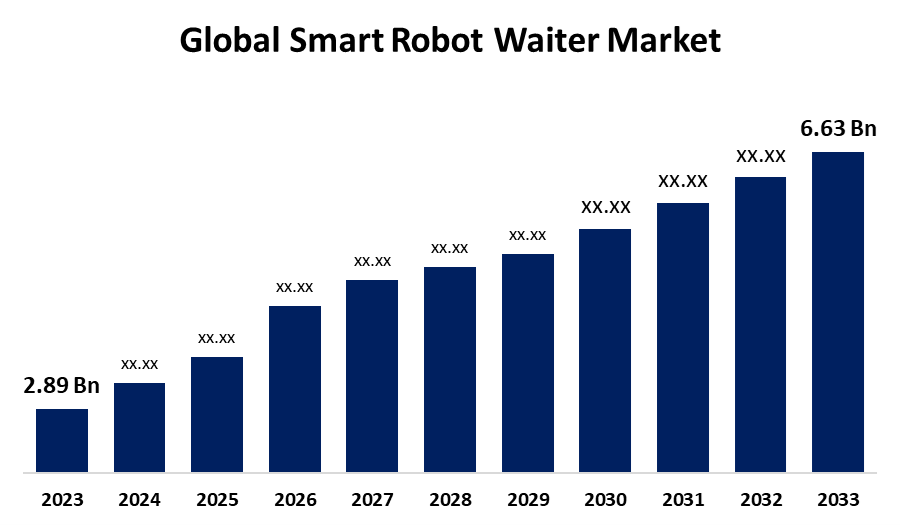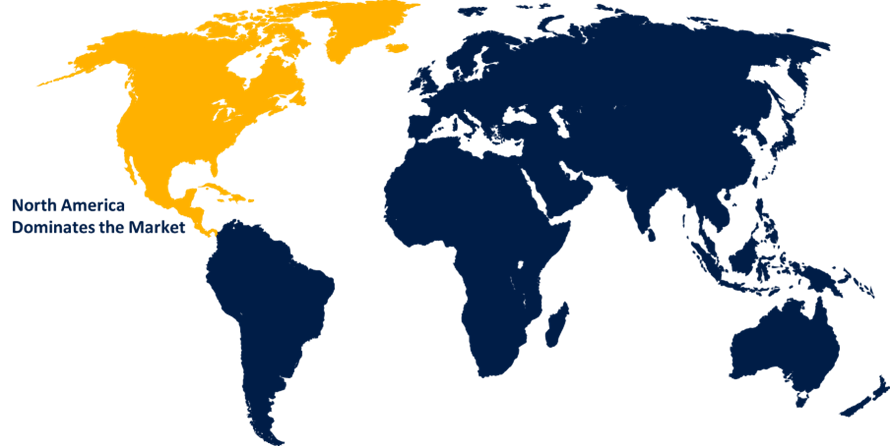Global Smart Robot Waiter Market Size, Share, and COVID-19 Impact Analysis, By Type of Robot (Autonomous Robots, Semi-Autonomous Robots, and Traditional Robot Systems), By Technology (AI & Machine Learning, Computer Vision, Navigation & Mapping Technologies, and Sensors & Actuators), By Application (Restaurants, Hotels, Cafeterias, and Banquet Halls), and By Region (North America, Europe, Asia-Pacific, Latin America, Middle East, and Africa), Analysis and Forecast 2023 - 2033
Industry: Semiconductors & ElectronicsGlobal Smart Robot Waiter Market Insights Forecasts to 2033
- The Global Smart Robot Waiter Market Size was Valued at USD 2.89 Billion in 2023
- The Market Size is Growing at a CAGR of 8.66% from 2023 to 2033
- The Worldwide Smart Robot Waiter Market Size is Expected to Reach USD 6.63 Billion by 2033
- Asia Pacific is expected to grow the fastest during the forecast period.

Get more details on this report -
The Global Smart Robot Waiter Market Size is anticipated to exceed USD 6.63 billion by 2033, growing at a CAGR of 8.66% from 2023 to 2033. The opportunities in the market for smart robot waiters, particularly in developing nations where urbanization is speeding up and there is widespread growth in the work sector.
Market Overview
Autonomous robots with AI and machine learning capabilities, known as "smart robot waiters," can carry out activities like bringing food and drinks to customers at hotels and restaurants. The smart robot waiters are made to serve food and drinks at restaurants. These robots can move around the restaurant delivering food and beverages to patrons due to sensors, cameras, and other cutting-edge technologies. Business owners find these robotic solutions more appealing as human prices rise and frictionless service becomes more important, particularly due to global health issues. The growing need for automation in the hospitality sector, which aims to boost productivity and customer service, is driving the growth in the smart robot waiter market. Technological developments in robotics, artificial intelligence (AI), and machine learning have improved the capabilities, effectiveness, and usability of smart robot waiters, leading to a rise in their application in the hospitality sector, which drives the smart robot waiter market. Restaurant chains and other hospitality companies are investing more in automation technologies, driving the smart robot waiter market.
Challenges
Navigating, detecting challenges, and naturally engaging with customers can be challenges for intelligent robots. Restaurant use of technology can be restricted by problems including its dependability and possible breakdowns.
Report Coverage
This research report categorizes the smart robot waiter market based on various segments and regions forecasts revenue growth and analyzes trends in each submarket. The report analyses the key growth drivers, opportunities, and challenges influencing the smart robot waiter market. Recent market developments and competitive strategies such as expansion, type launch, development, partnership, merger, and acquisition have been included to draw the competitive landscape in the market. The report strategically identifies and profiles the key market players and analyses their core competencies in each sub-segment of the smart robot waiter market.
Global Smart Robot Waiter Market Report Coverage
| Report Coverage | Details |
|---|---|
| Base Year: | 2023 |
| Market Size in 2023: | USD 2.89 billion |
| Forecast Period: | 2023-2033 |
| Forecast Period CAGR 2023-2033 : | 8.66% |
| 2033 Value Projection: | USD 6.63 billion |
| Historical Data for: | 2019-2022 |
| No. of Pages: | 230 |
| Tables, Charts & Figures: | 110 |
| Segments covered: | By Type of Robot, By Technology, By Application, By Region |
| Companies covered:: | Telpo, Lolly Ltd, Richtech Robotics, Keenon Robotics Co., Ltd., Service Robots, Pudu Technology Inc., JnS Robotics, Paaila Technology, Quantum robotics, Nuro, Bear Robotics, and Other Key Vendors. |
| Pitfalls & Challenges: | Covid-19 Empact, Challenges, Growth, Analysis |
Get more details on this report -
Driving Factors
The hospitality industry's growing need for automation and efficiency is driving the use of intelligent robot waiters. These robots provide several benefits, such as lower labor expenses, faster service, and better client satisfaction. The increasing need for efficiency and automation in the hospitality sector is the main factor driving the smart robot waiter market. The need for intelligent robot waiters is driven by the hospitality industry's growing focus on improving guest experiences.
Restraining Factors
Smart robot waiter implementation and acquisition can come with a hefty price tag. The upfront costs can prove a challenge for many small and medium-sized restaurants to explain when compared to hiring human labor, which can restrict the smart robot waiter market.
Market Segmentation
The smart robot waiter market share is classified into type of robot, technology, and application.
- The autonomous robots segment is estimated to hold the largest market revenue share through the projected period.
Based on the type of robot, the smart robot waiter market is classified into autonomous robots, semi-autonomous robots, and traditional robot systems. Among these, the autonomous robots segment is estimated to hold the largest market revenue share through the projected period. Autonomous robots can improve the eating experience and operational efficiency by navigating restaurants with ease, taking orders, delivering food, and even interacting with patrons.
- The AI & machine learning segment is anticipated to hold the largest market share through the forecast period.
Based on technology, the smart robot waiter market is divided into AI & machine learning, computer vision, navigation & mapping technologies, and sensors & actuators. Among these, the AI & machine learning segment is anticipated to hold the largest market share through the forecast period. Robots can learn from past interactions due to AI and machine learning, which also improves customer service by facilitating adaptive behavior and personalized recommendations.
- The restaurant segment is anticipated to hold the largest market share through the forecast period.
Based on the application, the smart robot waiter market is divided into restaurants, hotels, cafeterias, and banquet halls. Among these, the restaurant segment is anticipated to hold the largest market share through the forecast period. Smart robot waiters are being used by the main restaurants to improve client experiences, expedite operations, and alleviate labor shortages.
Regional Segment Analysis of the Smart Robot Waiter Market
- North America (U.S., Canada, Mexico)
- Europe (Germany, France, U.K., Italy, Spain, Rest of Europe)
- Asia-Pacific (China, Japan, India, Rest of APAC)
- South America (Brazil and the Rest of South America)
- The Middle East and Africa (UAE, South Africa, Rest of MEA)
North America is anticipated to hold the largest share of the smart robot waiter market over the predicted timeframe.

Get more details on this report -
North America is anticipated to hold the largest share of the smart robot waiter market over the predicted timeframe. A tech-savvy customer base and a lack of workers are driving the use of smart robot waiters in restaurants and hotels in North America, a developed market with a high level of technological adoption. Leading the market are the US and Canada, with a particular focus on automation and efficiency in the hotel sector. Consumer interest in cutting-edge technologies and a high degree of disposable money drive the growth of the smart robot waiter market in North America.
Asia Pacific is expected to grow at the fastest CAGR growth of the smart robot waiter market during the forecast period. Smart robot waiters are becoming increasingly popular in the Asia-Pacific region, which has a large population and a thriving food and beverage sector. Increased urbanization, rising disposable incomes, and increased interest in automation are driving the smart robot waiter market rapid rise in the Asia-Pacific region.
Competitive Analysis:
The report offers the appropriate analysis of the key organizations/companies involved within the smart robot waiter market along with a comparative evaluation primarily based on their type of offering, business overviews, geographic presence, enterprise strategies, segment market share, and SWOT analysis. The report also provides an elaborative analysis focusing on the current news and developments of the companies, which includes type development, innovations, joint ventures, partnerships, mergers & acquisitions, strategic alliances, and others. This allows for the evaluation of the overall competition within the market.
List of Key Companies
- Telpo
- Lolly Ltd
- Richtech Robotics
- Keenon Robotics Co., Ltd.
- Service Robots
- Pudu Technology Inc.
- JnS Robotics
- Paaila Technology
- Quantum robotics
- Nuro
- Bear Robotics
- Others
Key Target Audience
- Market Players
- Investors
- End-users
- Government Authorities
- Consulting And Research Firm
- Venture capitalists
- Value-Added Resellers (VARs)
Recent Development
- In October 2023, Lolly launched Fergus, their first robot waiter. After a year, the software company is happy to present the next generation of the quickly developing AI industry, Lolly Nova, which has been updated and is exciting.
- In January 2022, The R55 robot waiter, launched by Telpo, is intended for contactless meal delivery. In addition to obstacle avoidance, plate sensing, automated charging, multi-point distribution, and multi-robot collaboration, its 3D camera and SLAM navigation improve service efficiency.
Market Segment
This study forecasts revenue at global, regional, and country levels from 2023 to 2033. Spherical Insights has segmented the smart robot waiter market based on the below-mentioned segments:
Global Smart Robot Waiter Market, By Type of Robot
- Autonomous Robots
- Semi-autonomous Robots
- Traditional Robot Systems
Global Smart Robot Waiter Market, By Technology
- AI & Machine Learning
- Computer Vision
- Navigation & Mapping Technologies
- Sensors & Actuators
Global Smart Robot Waiter Market, By Application
- Restaurants
- Hotels
- Cafeterias
- Banquet Halls
Global Smart Robot Waiter Market, By Regional Analysis
- North America
- US
- Canada
- Mexico
- Europe
- Germany
- UK
- France
- Italy
- Spain
- Russia
- Rest of Europe
- Asia Pacific
- China
- Japan
- India
- South Korea
- Australia
- Rest of Asia Pacific
- South America
- Brazil
- Argentina
- Rest of South America
- Middle East & Africa
- UAE
- Saudi Arabia
- Qatar
- South Africa
- Rest of the Middle East & Africa
Frequently Asked Questions (FAQ)
-
What is the CAGR of the smart robot waiter market over the forecast period?The smart robot waiter market is projected to expand at a CAGR of 8.66% during the forecast period.
-
What is the market size of the smart robot waiter market?The Global Smart Robot Waiter Market Size is expected to grow from USD 2.89 billion in 2023 to USD 6.63 billion by 2033, at a CAGR of 8.66% during the forecast period 2023-2033.
-
Which region holds the largest share of the smart robot waiter market?North America is anticipated to hold the largest share of the smart robot waiter market over the predicted timeframe.
Need help to buy this report?